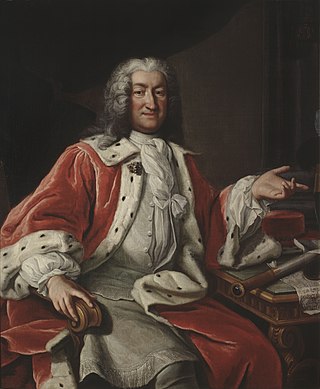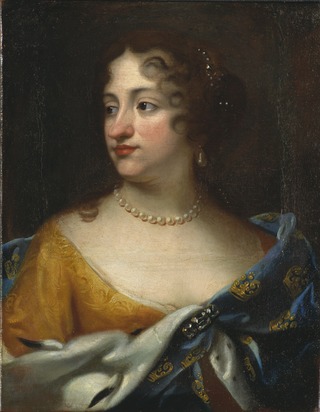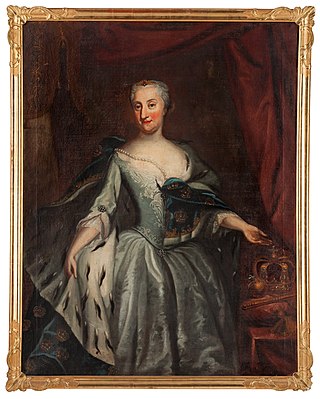| Years in Sweden: | 1715 1716 1717 1718 1719 1720 1721 |
| Centuries: | 17th century · 18th century · 19th century |
| Decades: | 1680s 1690s 1700s 1710s 1720s 1730s 1740s |
| Years: | 1715 1716 1717 1718 1719 1720 1721 |

Events from the year 1718 in Sweden
| Years in Sweden: | 1715 1716 1717 1718 1719 1720 1721 |
| Centuries: | 17th century · 18th century · 19th century |
| Decades: | 1680s 1690s 1700s 1710s 1720s 1730s 1740s |
| Years: | 1715 1716 1717 1718 1719 1720 1721 |

Events from the year 1718 in Sweden

Adolf Frederick, or Adolph Frederick was King of Sweden from 1751 until his death in 1771. He was the son of Christian August of Holstein-Gottorp, Prince of Eutin, and Albertina Frederica of Baden-Durlach. He was an uncle of Catherine the Great and husband to Louisa Ulrika of Prussia.

Frederick I was King of Sweden from 1720 until his death, having been prince consort of Sweden from 1718 to 1720, and was also Landgrave of Hesse-Kassel from 1730. He ascended the throne following the death of his brother-in-law absolutist Charles XII in the Great Northern War, and the abdication of his wife, Charles's sister and successor Ulrika Eleonora, after she had to relinquish most powers to the Riksdag of the Estates and thus chose to abdicate. His powerless reign and lack of legitimate heirs of his own saw his family's elimination from the line of succession after the parliamentary government dominated by pro-revanchist Hat Party politicians ventured into a war with Russia, which ended in defeat and the Russian tsarina Elizabeth getting Adolf Frederick of Holstein-Gottorp instated following the death of the king. Whilst being the only Swedish monarch called Frederick, he was Frederick I of Hesse-Kassel and thus Frederick I also of Sweden, though other Swedish monarchs with non-repeating names have not been given numerals.

Ulrika Eleonora or Ulrica Eleanor, known as Ulrika Eleonora the Younger, was Queen of Sweden, reigning in her own right from 5 December 1718 until her abdication on 29 February 1720 in favour of her husband King Frederick, and then as his consort until her death.

Charles XII, sometimes Carl XII or Carolus Rex, was King of Sweden from 1697 to 1718. He belonged to the House of Palatinate-Zweibrücken, a branch line of the House of Wittelsbach. Charles was the only surviving son of Charles XI and Ulrika Eleonora the Elder. He assumed power, after a seven-month caretaker government, at the age of fifteen.

Count Arvid Bernhard Horn af Ekebyholm was a Swedish general, diplomat and politician, a member of the noble Horn family. He served twice as President of the Privy Council Chancellery and was one of the leading figures of the Swedish Age of Liberty.

Georg Heinrich von Görtz, Baron of Schlitz, diplomat in Swedish service, was born in Holstein and educated at Jena.

Ulrika Eleonora of Denmark was Queen of Sweden as the wife of King Charles XI. She is often admired for her generosity and charity.

Hedvig Sophia Augusta of Sweden, Duchess of Holstein-Gottorp, was the eldest child of Charles XI of Sweden and Ulrike Eleonore of Denmark. She was heir presumptive to the Swedish throne from her birth until that of her brother one year later and again from the start of his reign as King of Sweden, in 1697, until her death and the regent of the duchy of Holstein-Gottorp for her minor son from 1702 to 1708. Some sources refer to her as Sofia.

Charles Frederick, Duke of Schleswig-Holstein-Gottorp was a Prince of Sweden and Duke of Schleswig-Holstein-Gottorp and an important member of European royalty. His dynasty, the Dukes of Schleswig-Holstein-Gottorp, were a cadet branch of the ancient House of Oldenburg, which at that time was ruling Denmark-Norway. His mother was a sister of Charles XII of Sweden. Charles Frederick married a daughter of Peter the Great and became the father of the future Peter III of Russia. As such, he is the progenitor of the Russian imperial house of Holstein-Gottorp-Romanov and the patrilineal ancestor of all Russian emperors starting with Peter III, except for Catherine II.

Hedwig Eleonora of Holstein-Gottorp was Queen of Sweden from 1654 until 1660 as the wife of King Charles X Gustav. She served as regent during the minority of her son, King Charles XI, from 1660 until 1672, and during the minority of her grandson, King Charles XII, in 1697. She also represented Charles XII during his absence in the Great Northern War from 1700 until the regency of her granddaughter Ulrika Eleonora in 1713. Hedwig Eleonora was described as a dominant personality, and was regarded as the de facto first lady of the royal court for 61 years, from 1654 until her death.

Count Carl Gustav Rehnskiöld was a Swedish Field Marshal (fältmarskalk) and Royal Councillor. He was mentor and chief military advisor to King Charles XII of Sweden, and served as deputy commander-in-chief of the Carolean Army, an army he assisted both in its education and development.

Frederick IV was the reigning Duke of Holstein-Gottorp.

During the Great Northern War, the fortress of Tönning (Tønning) in the territory of Holstein-Gottorp, an ally of the Swedish Empire, was besieged twice. Denmark-Norway was forced to lift the first siege in 1700, but a combined force of the anti-Swedish coalition successfully besieged and took Tönning in 1713–1714.

Events from the year 1719 in Sweden
Events from the year 1715 in Sweden

Events from the year 1700 in Sweden

Events from the year 1692 in Sweden

The 1719 Instrument of Government adopted on 21 February 1719 by the Riksdag of the Estates, was the constitution of the Kingdom of Sweden from 1719 to 1720. Although only in force for a few months, it has great significance in Swedish history, as its promulgation marked the end of the country's first period of absolutism (1680-1719) and the beginning of the period of constitutional monarchy and parliamentary government traditionally known as the Age of Liberty.
The Holstein Party, was the name of a political group in 18th-century Sweden which played a significant role in politics after the death of Charles XII of Sweden in 1718 and until 1727.